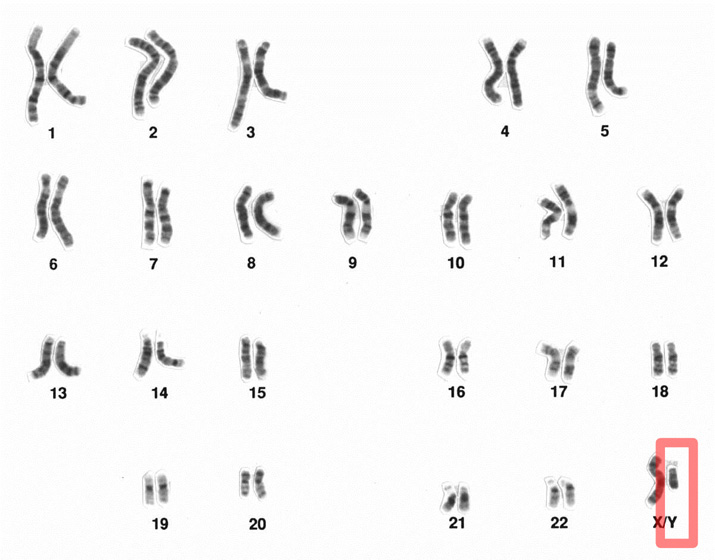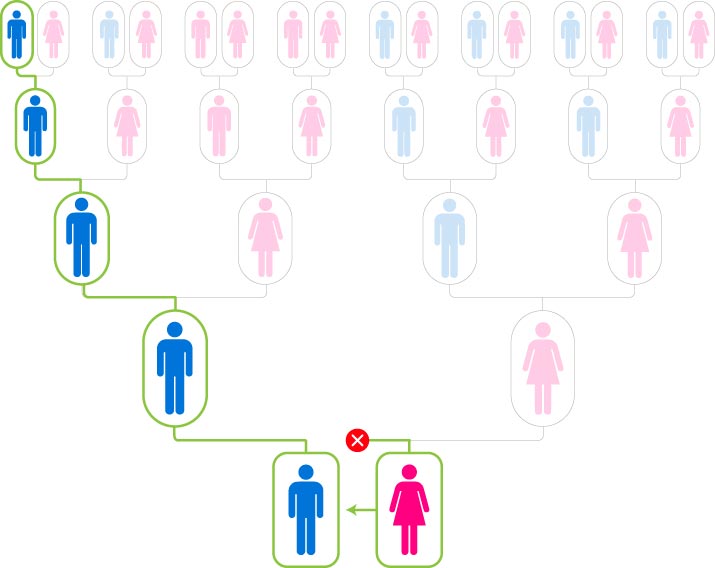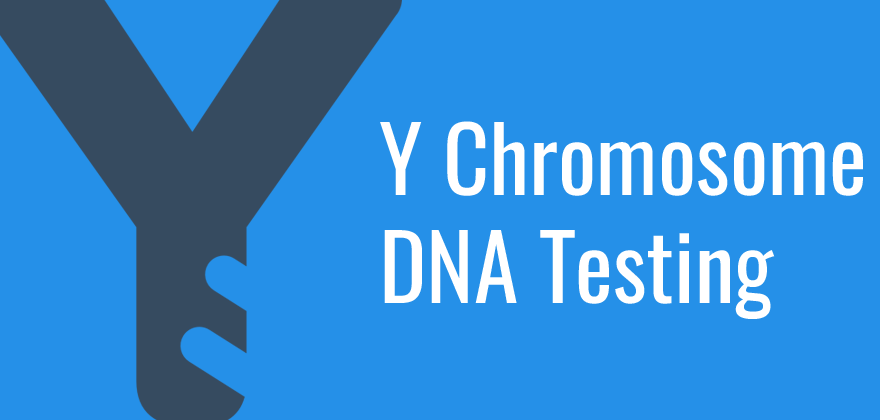Why should you care about Y-DNA?
Because it has great benefits for your genetic genealogy research!
Y-DNA test results can help determine a common paternal ancestor- and can, therefore, help adoptees locate family members, provide more genetic cousins for your research, and determine the ancient origins of paternal family lines.
Understanding how Y-DNA testing works and its potential applications is key to gaining the most advantage from this unique research tool.
What is Y-DNA?
The 23 pairs of chromosomes in each of your cells include a pair of sex chromosomes: Women have two X chromosomes, and men have an X and a Y chromosome.

The Y chromosome is passed down from fathers to sons almost completely unchanged, which means that Y-DNA inheritance will remain the same over a long period of time (Genetic Genealogy in Practice).

The Y chromosome is also very short, containing only 200 of the approximately 20-25,000 genes found in the human genome (Family Tree Guide to DNA Testing). Y may be small, but it has mighty value for genealogists!
The Importance of Y-DNA
Y-DNA testing can offer great benefits to family researchers.
Because a man’s Y-DNA chromosome is nearly identical to his father, grandfather, great-grandfather, and so on through the generations, a Y-DNA line can be traced back hundreds, or even thousands of years (GGP)!
Because a family surname follows the patrilineal line in many cultures, there is often a strong connection between the family name and the Y chromosome.
This makes Y-DNA testing invaluable for male adoptees looking for clues to their biological paternal surname and paternal family members (FTG).
A caveat is that Y-DNA testing, like atDNA testing, could also reveal misattributed parentage- the test-taker’s results could indicate a completely different family name connection or provide unexpected genetic matches.
Exhaustive research should always be done before drawing any conclusions.
The advantage of having the same Y chromosome passed down through the centuries is also helpful when trying to decipher whether a paternal line had a specific ethnic or geographic origin.
For example, if your patrilineal line had African or Native American roots, those identifying pieces of Y-DNA will remain the same throughout dozens of generations (GGP).
Additionally, Y-DNA testing is helpful when trying to narrow down genetic matches on a specific paternal line.
While autosomal (atDNA) provides matches who share on any of the other 22 pairs of chromosomes, Y-DNA cousin matches will only share on the Y chromosome. See our guide to autosomal DNA testing kits.
Completing a Y-DNA test is therefore beneficial when you have hundreds of atDNA matches but are having difficulty determining who belongs on your paternal line of interest- Y-DNA test results will also provide many matches, but they will all belong to that same Y ancestral line.
Conversely, a problem with having an unchanging Y chromosome is that it cannot clearly determine a common ancestor relationship within recent generations.
All direct male descendants of a paternal line share the same Y-DNA, regardless of how long ago they lived (FTG).
Y-DNA testing can only determine whether two ancestors may have had a male familial relationship- father and son, brothers, male cousins, uncle/nephew, or estimate how many generations have passed since two men shared a common paternal ancestor.
This is why it is important to utilize both Y-DNA and atDNA testing to gain the most understanding of your results.
Combining atDNA test results with your Y-DNA results can help narrow down how far back a common ancestor is on the Y-DNA line, as atDNA reveals genetic matches that generally exist within a 1-8 generation timeframe (FTG).
Choosing the Right Test Taker
Since the Y chromosome is only inherited by men, women cannot take a Y-DNA test- but they can still take advantage of Y-DNA testing to help break down their paternal-line brick walls! It is important to understand how the Y chromosome is inherited through your family tree in order to select a potential Y-DNA test taker.
Look for an unbroken father-to-son line to your target ancestor- if a line “daughtered out,” in other words, if a father had only daughters and no sons, then the Y chromosome inheritance stopped with that father.
The easiest way to determine a potential test-taker is to draw or print out a family tree for your target ancestor and highlight all men descending from that ancestor who would have inherited that man’s Y chromosome (GGP).
Sometimes to find an eligible test-taker, you may need to reach out to a distant cousin.
Y-DNA Testing
There are two different types of Y-DNA testing available- Short Tandem Repeat (STR) and Single Nucleotide Polymorphism (SNP).
Similar to the more common atDNA test, the results are compared to other test-takers in the testing company’s database to find genetic matches.
Y-DNA STR Testing
STR testing is most commonly used to begin Y-DNA research.
STR markers are short regions located along the Y chromosome, and the test looks at these markers to find sequences of DNA units that repeat a variable number of times.
Those unique sequences are passed down through generations and can help determine a genetic relationship between two test-takers.
Family Tree DNA, the only company that currently provides Y-DNA matching, offers 37, 67 or 111 marker tests.
More markers tested can provide better results, so testing 67 or 111 markers is recommended (FTG).
Y-DNA SNP Testing
Single Nucleotide Polymorphisms are variations in a single unit of DNA, rather than a region, so this type of test digs much further into the details of Y-DNA.
Most people will start with a Y-DNA STR test and may use a Y-DNA SNP test to further define a test-taker’s results and determine their ancestral haplogroup- their branch of the human genetic tree (FTG).
Understanding Test Results
Y-DNA STR test results will display the names of the markers tested, and a corresponding value for those markers.
Most marker names begin with “DYS” (D for DNA, Y for the Y chromosome, S for the segment) and the marker number, for example, DYS438.
The value given for a marker equals how many repeats of a sequence were found at that location. So if DYS438 has a value of 7, that means 7 sequence repeats were found at that location (FTG).
Comparing the values of the same markers for two or more men can determine if they are a genetic match- the more values that match, the more likely those men are related.
And, the more markers you test, the more accuracy you will gain in determining if test-takers are related to each other.
For example, a difference of 2 on a 37-marker test may indicate less possibility of a genetic match, but a difference of 2 on a 111-marker test offers a much stronger possibility of a genetic match.
The difference threshold grows as you test a larger amount of markers, as does the pool of possible genetic cousins (FTG).
Y-DNA test results also involve haplogroups, which can help determine what particular line of the human ancestral DNA tree a test-taker’s Y chromosome originates from.
Y-DNA STR testing will provide a haplogroup estimate, while the more intensive Y-DNA SNP test provides a definitive haplogroup determination.
A Y-DNA haplogroup starts with a main branch, and then continues into narrower and narrower subgroups, which are defined by one or more SNP mutations.
Each unique mutation will also determine the ancestral and ethnic origins of the haplogroup.
For example, the Y-DNA haplogroup J-M67 is found in those with ancestry in the Caucasus, Italy, and the Iberian Peninsula (FTG).
The resources provided below will give you a great in-depth look at Y-DNA testing and haplogroup research.
Where to Buy a Y-DNA Test
Not all DNA testing companies provide Y-DNA testing and those that do, provide different types of testing.
Be sure to do your research so you can select the testing company that meets your needs.
23andMe
23andMe provides a Paternal Haplogroup report for males who complete either the Ancestry Service or Health + Ancestry Service testing kits.
While the Paternal Haplogroup report will provide broad information on the test subject’s haplogroup, 23andMe does not provide any Y-DNA matching at this time.
Living DNA
Similar to 23andMe, Living DNA offers a “Fatherline” report for male autosomal test-takers, containing general haplogroup results from their Y-DNA. No Y-DNA matching is available at this time.
Family Tree DNA
Family Tree DNA has been offering Y-DNA STR testing since 2000, and has the largest Y-STR database in the world, making them the go-to for detailed, matchable Y-DNA results.
Family Tree DNA offers many useful tools for researchers, including their massive match database, a paternal migration map, and access to thousands of Y-DNA research projects.
Family Tree DNA currently offers 4 different testing options:
- Y-37: examines only 37 STR markers
- Y-67: examines 67 STR markers
- Y-111: examines 111 STR markers
- Big Y-700: This test examines 700 STR markers and 400,000 SNPs on the Y chromosome. This is the only test option that offers the Y-DNA SNP testing, which is ideal for those who are looking for the most detailed haplogroup information available.
Resources
There are lots of resources available to help you learn more about Y-DNA!
Books
Genetic Genealogy in Practice, Blaine T. Bettinger and Debbie Parker Wayne (National Genealogical Society, 2016)- this workbook devotes a whole chapter on Y-DNA
The Family Tree Guide to DNA Testing and Genetic Genealogy 2nd Edition, Blaine T. Bettinger (Family Tree Books, 2019) – Bettinger’s book also goes in-depth on Y-DNA testing.
There are also many great books offering engrossing and educational genetic genealogy case studies, easily found online by conducting a search for “genetic genealogy books!”
Y Surname Projects
These are collaborative efforts to bring together individuals with the same or similar surnames, or those who share the same haplogroups, to compare Y-DNA results and exchange information.
Family Tree DNA hosts more than 8,000 different DNA projects, including Y-DNA. Test takers will find the option to search for projects by surname or in an alphabetical listing.
Cyndi’s List offers a listing of Surname DNA Studies & Projects
Additionally, you can often find Y-DNA surname projects by conducting an online search for “Y DNA projects.”
Websites
The ISOGG Wiki (International Society of Genetic Genealogy) is a must-bookmark site for a treasure trove of genetic genealogy resources!
FAQ
Does 23andme test the Y chromosome?
23andMe provides limited testing of the Y chromosome for male customers. Along with their paternal haplogroup, they are given a visual report and patrilineal timeline. This allows customers to see how their paternal line has evolved over time. It also provides insights into the movement of ancient populations.
Conclusion
Y-DNA can be a powerful tool in your genetic genealogy toolbox, once you understand its applications and how it can benefit your research. Y-DNA may be just the thing you need to find that missing connection in your paternal family tree!




Very well-written article, easy to understand. I too have a passion for genealogy, and I am convinced DNA and Y DNA will help us fill in gaps in our family histories. My main barrier is on my paternal side. To make things more difficult, my male ancestors had very few male descendants, with many having short life spans. My Y haplogroup is G-M201, which is rather rare with very limited matches to-date with my Ellis surname. I belong to the Big Y project sponsored by ftDNA and to the Ellis Surname project sponsored by WikiTree.